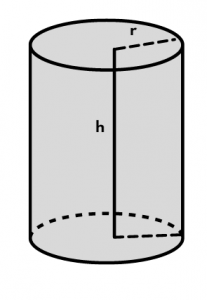Solid Shapes with Examples and FAQs
What are solid shapes?
The shapes the are 3 dimensional and occupy matter(space) are known as solid shapes. The three dimensions are length, breadth and height or depth of the object.
The following are some solid shapes that are a part of our day to day life:



Types of Solids and their Specific Characteristics
1. Cube

Characteristics of a Cube:
- A cube comprises 6 square faces, 12 edges and 8 vertices.
- If the edge length is ‘a’ units, then:
Lateral Surface Area(LSA) =4 a^{2}
Total Surface Area(TSA) =6 a^{2}
Volume =a^{3}
2. Cuboid

Characteristics of a cuboid:
- A cuboid comprises 6 rectangular faces, 12 edges and 8 vertices.
- If the length, breadth and height of a cuboid is l, b and h units respectively then:
Lateral Surface Area(LSA) = 2(l + b)h
Total Surface Area(TSA) = 2(lb + bh + lh)
Volume = lbh
3. Cylinder

Characteristics of a cylinder:
- Comprises of two circular planes as bases and one curved surface.
- It also has 2 edges and no vertices.
- If the height of a cylinder is ‘h’ units and the radius of its circular bases if ‘r’ units, then:
Curved Surface Area(CSA) = 2πrh
Total Surface Area(TSA) = 2πr(r + h)
Volume =\pi r^{2} h
4. Cone

Characteristics of a cone:
- Comprises of 2 faces: 1 circular plane as the base and 1 curved surface, one edge and one vertex.
- If the height of a cone is ‘h’ units, slant height is ‘l’ units and radius of the circular base is ‘r’ units, then:
Curved Surface Area(CSA) = πrl
Total Surface Area(TSA) =πr(r+l)
Volume =\frac{1}{3} \pi r^{2} h
5. Sphere

Characteristics of a sphere:
- Comprises of 1 curved surface(face), no edge and no vertex.
- Each point on a sphere is equidistant from its centre and i.e., its radius, if this radius is ‘r’ units, then:
Total Surface Area(TSA) =4 \pi r^{2}
Volume =\frac{4}{3} \pi r^{3}
6. Hemisphere

Characteristics of a hemisphere:
- Comprises of 1 circular plane as a surface(face) and 1 flat circular face, 1 edge and no vertex.
- Each point on a hemisphere is equidistant from its centre and i.e., its radius, if this radius is ‘r’ units, then:
Curved Surface Area(CSA) =2 \pi r^{2}
Total Surface Area(TSA)=3 \pi r^{2}
Volume=\frac{2}{3} \pi r^{3}
Examples
Identify the solids.
a. 
b. 
c. 
Solution:
The solids are:
a. Box- Cube
b. Ice Cream- Cone
c. Building- Cuboid
Frequently Asked Questions
1. What are solid shapes?
Ans: The shapes the are 3 dimensional and occupy matter(space) are known as solid shapes. The three dimensions are length, breadth and height or depth of the object.
2. Mention some common examples of solids?
Ans: Some common solids are cube, cuboid, cylinder, cone, sphere and hemisphere, etc.
3. Which Solid has no edge?
Ans: The solid which doesn’t have an edge is a sphere.
4. Do all solids have curved faces?
Ans: No, it is not necessary for solids to have curved faces. Some solids, for example, cubes and cuboids have no curved surface.
